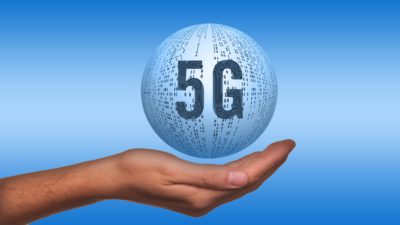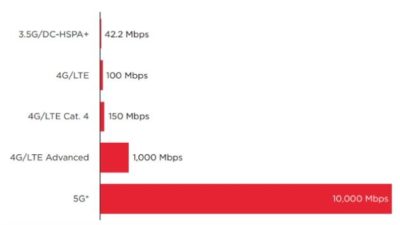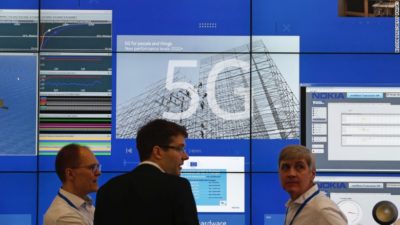Just five years after the first 4G smartphone hit the market, the wireless industry is already preparing for 5G.

Each of the four nationwide cell phone carriers, as well as smartphone chipmakers and the major network equipment companies are working on developing 5G network technology for their customers.
There are many significant hurdles that all the industry players have to clear before you’ll see a little 5G symbol next to the signal bars on your smartphone screen. For example, it has yet to be determined what 5G even means, let alone what it will look like and when it will get here.
But as consumers use up rapidly growing amounts of 4G bandwidth watching streaming videos on their phones, 5G will soon become a necessity. As telecom engineers work furiously to develop 5G technology, we’re getting a clearer picture of the who, what, where, when and why of 5G.
What is 5G?

The “G” in 3G, 4G and 5G stands for “generation.” So 5G will be the fifth generation of wireless network technology.
The standards for 5G have not yet been set. According to Bill Smith, president of AT&T’s (T, Tech30)network operations, 5G will likely be defined in 2018, and the standards for 5G will codified sometime in 2019 by the standards-setting International Telecommunication Union, a branch of the United Nations. The standards will determine which wireless technologies can be called “5G,” as well as what its characteristics must include, such as how fast it will be.
Still, it’s possible to make a very educated guess about what 5G will look like based on the emerging 5G technologies that the wireless industry is experimenting with.
Here’s the elevator pitch: 5G will be faster, smarter and less power-hungry than 4G, enabling a slew of new wireless gadgets. 5G will let us have faster smartphones, more smart-home devices and longer-lasting wearable gizmos.
How fast will 5G be?

5G has the potential to offer speeds up to 40 times faster than 4G — fast enough to stream “8K” video in 3-D or download a 3-D movie in about 6 seconds (on 4G, it would take 6 minutes).
Unfortunately for consumers, there’s a difference between lab experiments and reality. Peak speeds are fun to dream about, but in the real world, actual speeds are much slower than promised.
Nokia (NOK), one of the biggest 5G players, believes that its 5G technology will allow for real-world speeds of about 100 Megabits per second when the network is most congested — that’s about four times faster than 4G’s top speed.
Another characteristic of 5G is that it will have ultra-low latency, meaning that it could drastically reduce the amount of time it takes for the network to respond to your commands. That could give the appearance of much faster loading websites, apps, videos and messages.
How will it work?
A lot of the wireless companies’ 5G experimentation is taking place in super-high frequencies — as high as 73,000 MHz. Today’s cell phone networks broadcast signal in a range of 700 MHz to 3,500 MHz.
The advantage of high-frequency signals is that they’re capable of providing significantly faster data speeds. The disadvantage is that they travel much shorter distances and they can’t easily penetrate walls. That means thousands — perhaps even millions — of mini cell towers, or “small cells” would need to be placed on top of every lamp post, every building, inside every home and potentially every room.
That presents a host of problems. How can cell phone companies possibly process all that data? There are companies, such as Google’s recently acquired Alpental, that are working on those “backhaul” issues. But they’re not so close to a solution, according to Akshay Sharma, wireless infrastructure analyst at Gartner.
That’s why 5G might complement 4G, rather than outright replace it. In buildings and in crowded areas, 5G might provide a speed boost. But when you’re driving down the highway, 4G could be your only option — at least for a while.
When is 5G coming?

None of these questions are going to be answered any time soon. The industry’s consensus is that it will run 5G experiments in South Korea during the 2018 Winter Olympics, with mass deployments beginning sometime in 2020.
Yet Verizon (VZ, Tech30) has said that it is working on 5G technology with the aim of bringing it to market much sooner — as early as 2017.
With all the questions surrounding 5G and all the wrinkles that need to be ironed out, it’s exceedingly unlikely that anything Verizon does will be widely deployed. For example, the smartphone makers will need to develop chips that are capable of sending and receiving 5G signal without driving costs significantly higher.
Have questions?
Get help from IT Experts/Microsofts Cloud Solutions Partner
Call us at: 856-745-9990 or visit: https://southjerseytechies.net/
South Jersey Techies, LLC is a full Managed Web and Technology Services Company providing IT Services, Website Design Services, Server Support, Network Consulting, Internet Phones, Cloud Solutions Provider and much more. Contact for More Information.